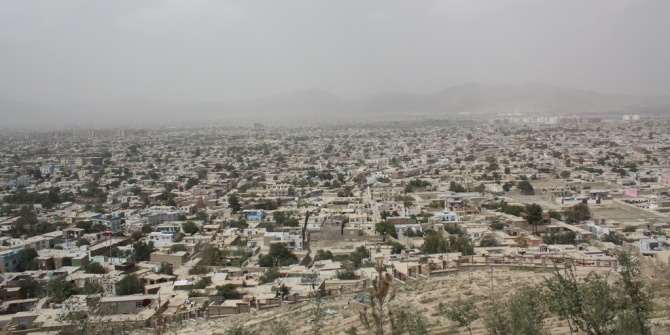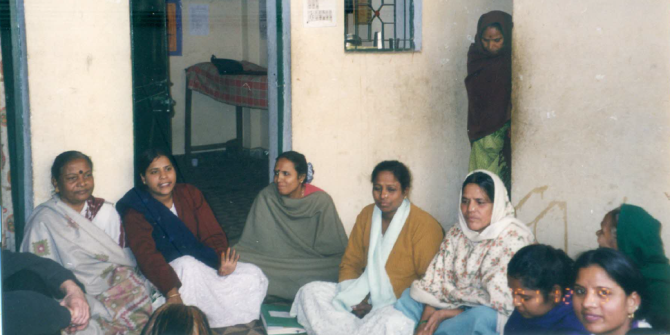The recent attack on the Hazara Shiite community was claimed by ISIS, revealing the growing penetration of its Afghan affiliate Wilayat Khorasan. In this article, Sajjan Gohel discusses the significance of the latest attack, outlines the origins of Wilayat Khorasan and discusses the escalating rivalry between the new group and the Afghan Taliban.
On 23 July 2016 80 people from the minority Hazara Shiite community were killed and 230 injured after two suicide bombers struck a peaceful gathering in Afghanistan’s capital, Kabul, who were protesting over government plans for a power project to bypass Bamiyan, a predominantly Hazara province in central Afghanistan.
Responsibility for the attack was claimed by ISIS via the group’s news agency, Amaq, which said it had sent two fighters with suicide belts to detonate among “a Shiite gathering”. The incident marks the first attack by ISIS in Kabul, and its largest ever in Afghanistan. Previously, the worst attack on the Hazaras was in 2011 when twin blasts in Kabul and Mazar-e-Sharif killed as many as 80 worshippers, who had gathered to commemorate the holy Shiite day of Ashura.
The attack is also the deadliest in Kabul since 2001 and raises fears of sparking a sectarian conflict. Since Afghanistan’s civil war in the 1990s the country has proved largely immune to widespread sectarian violence that persists in Pakistan as well as Iraq and Syria, where ISIS has deliberately tried to stoke communal tensions.
In addition to the attack on the Hazaras, security in Kabul has become increasingly unstable since the massive Afghan Taliban attack on 12 April, 2016 which killed 64 people. That attack was in close proximity to the Afghan Presidential Palace as well as the British and U.S. Embassies.

ISIS, through its Afghan affiliate, Wilayat Khorasan, has concentrated attacks in a few districts in the country’s eastern provinces, where they have also fought with the Afghan Taliban over territory. Their fighting force of around 3,000 fighters is relatively small, but the fact that it was non-existent three years ago and after the attack on the Hazaras attack, it will stoke fears that Wilayat Khorasan is gaining strength in the country. Indeed, Wilayat Khorasan is an entity that should not be ignored as it quietly and steadily grows across Afghanistan, especially in Kabul.
Origins of Wilayat Khorasan
Confirmation of ISIS’s expansion in Afghanistan can be pinpointed to a January 2015 audiotape message issued by Abu Muhammad al-Adnani, the head of ISIS’s external operations, who officially announced the group’s ‘expansion’ into the ‘lands of Khorasan.’ The new entity would be called Wilayat Khorasan and led by Hafiz Saeed Khan who was a student at the Dar-ul-Ulum Islamia, a madrasa in Hangu Town Pakistan, which has produced many Taliban leaders.
Khan had initially joined the Afghan Taliban after Operation Enduring Freedom. In 2007, Batiullah Mehsud formed the Tehreek-e-Taliban Pakistan (TTP) and made Khan an Emir and religious leader for Orakzai Agency, Pakistan. Following the deaths of Batiullah Mehsud and his successor Hakimullah Mehsud, Khan grew disillusioned with the TTP under its current leader Mullah Fazullah and along with several other ex-TTP commanders, he pledged allegiance to ISIS in October 2014. The Islamic Movement of Uzbekistan, once an affiliate of al-Qa’ida, also defected to ISIS and aligned itself with Wilayat Khorasan.
As a result of these origins, Wilayat Khorasan also has a strong presence in parts of Pakistan, especially the tribal areas, where they have co-opted local militant groups like Jundallah who were once associated with the TTP. The leadership is predominantly Pakistani-Pashtun, but there are Afghans like Sheikh Muhskin, their Emir in Kunar Province who pledged allegiance to ISIS in January 2015.
On 18 April 2015 Wilayat Khorasan announced their presence in Afghanistan by carrying out a suicide attack in Jalalabad when one of their fighters on a motorbike blew himself up in front of a bank, killing 33 people and injuring more than 100 others. The group initially developed a presence in the eastern provinces of Afghanistan, notably Nuristan, Kunar, Nangarhar, Ghazni and Zabul, but there has also been a slow creep to other parts of the country. For example, they have been involved in heavy fighting in the western province of Farah and the southern province of Helmand and were also behind the execution of nine Afghan employees of a Czech aid organisation in the relatively peaceful northern province of Balkh which borders Uzbekistan and Tajikistan on 2 June 2015. The fact that the terrorist outfit can now carry out large mass casualty attacks in Kabul illustrates the level of their proliferation.
Disturbingly, Wilayat Khorasan have been more brutal and vicious in their attacks than even the Afghan Taliban and the TTP. Abdul Rahim Muslim Dost, an ex-Guantanamo Bay detainee, swore fidelity to Wilayat Khorasan in 2014 and became a recruiter for them. However, Dost later revoked his pledge to the group because of the intensity of their violence towards Afghan civilians.
Rivalry with the Afghan Taliban
On 8 June 2015, 10 members of the Afghan Taliban were beheaded by the Wilayat Khorasan in a rural part of Nangarhar province. Wilayat Khorasan wanted to make a statement of intent that they see themselves as a rival to the Afghan Taliban and also illustrate a show of strength as well as intimidate the Taliban, the Ashraf Ghani government and the West.
Wilayat Khorasan has actively been trying to undermine the Afghan Taliban through propaganda, with the assistance of ISIS’s media machine, and in head-on battles with them due to conflicting beliefs and aspirations. For example, In Dabiq #13, ISIS’s online journal, Hafiz Saeed Khan described the Afghan Taliban as relying on Pashtunwali, the tribal code of Pashtuns, in its legal decision-making, whereas, Wilayat Khorasan adopts a warped version of Shari’ah Law. The Afghan Taliban wants an Islamic Emirate of Afghanistan but arguably that is the limit if its expansionist goals. Wilayat Khorasan, on the other hand, wants a caliphate beyond the confines of Afghanistan to also include all of Pakistan, Tajikistan, Kyrgyzstan, Uzbekistan, Turkmenistan as well as Indian administered Kashmir and the Chinese province of Xinjiang which has ethnic Uyghur Muslims.
On 12 July 2015, ISIS released an audio statement and then an article in their Dabiq magazine claiming that the enduring Afghan Taliban leader Mullah Omar was dead. This pre-empted the official confirmation of Mullah Omar’s death by the Taliban on 29 July, 2015. By seizing the narrative, of Mullah Omar’s death, ISIS helped exacerbate existing fractures leading to some permanent major divisions within the Afghan Taliban. Akhtar Mansour succeeded Mullah Omar but the Afghan Taliban began to fracture, resulting in defections to Wilayat Khorasan. When Manosur was killed in a U.S. drone strike on 21 May, 2016, Mawlawi Haibatullah Akhundzada took over. However, he has been unable to stop the trickle of defections to Wilayat Khorasan
Wilayat Khorasan’s propaganda and indoctrination is modelled on ISIS. Their outfits in videos are similar to those worn by ISIS in its gruesome murder videos. Some videos show the group to be regimental, organised and mobile. In reality, they are more of rag-bag bunch of fighters, but one that has on multiple occasions proved to be deadly and effective.
Just like ISIS, Wilayat Khorasan has its own Caliphate Radio to reach its followers and potential recruits, although it often experiences transmission problems because of US airstrikes. However, the strikes do not disrupt the group’s Fatah Pamphlet which is distributed and circulated by hand and is modelled on the Afghan Taliban’s “night letters”, a method of communication to rural and urban populations in Afghanistan that expressed their demands, instructions, threats, or warnings.
Afghanistan is experiencing a strange paradox where the Afghan Taliban are showing fractures whilst also increasing the tempo of the violence. At the same time they are starting to face increasing competition in the violence stakes from Wilayat Khorasan who are spreading their tentacles across Afghanistan and Pakistan. As the West struggles to find a solution to the Taliban insurgency, and with the prospect of reconciliation talks are a distant reality, Wilayat Khorasan will seek to exacerbate tensions by sowing sectarian and communal discord. The 23 July attack on the Hazaras is therefore unlikely to be a one-off incident. It’s a prelude to more problems by the terrorist group.
Note: This article gives the views of the author, and not the position of the South Asia @ LSE blog, nor of the London School of Economics. Please read our comments policy before posting.
About the Author
Sajjan Gohel is International Security Director at the Asia-Pacific Foundation, Senior Advisor to the Partnership for Peace Consortium’s Combating Terrorism Working Group and a Visiting Teacher in the International History Department at the LSE. Read his previous South Asia @ LSE posts here.








Good overall article detailing Wilayat Khorasan… more details on their emergence in AfPak, claims of responsibility, statements and comments on WK from Islamic Emirate (Taliban) can be read on my blog under Wilayat Khorasan or Islamic State, Islamic Emirate…
https://activist1.wordpress.com/2015/01/12/are-is-gaining-a-foothold-in-afpak-new-video-release-shows-some-allegiance-in-the-region/